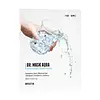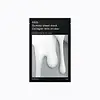What's inside
What's inside
 Key Ingredients
Key Ingredients

 Benefits
Benefits

 Concerns
Concerns

No concerns
 Ingredients Side-by-side
Ingredients Side-by-side

Water
Skin ConditioningButylene Glycol
HumectantGlycerin
HumectantPentylene Glycol
Skin ConditioningMethyl Gluceth-20
HumectantNiacinamide
SmoothingAcetyl Hexapeptide-8
HumectantSodium Hyaluronate
HumectantArginine
MaskingAllantoin
Skin ConditioningPanthenol
Skin ConditioningHyaluronic Acid
HumectantCaffeine
Skin ConditioningCarica Papaya Fruit Extract
Skin Conditioning1,2-Hexanediol
Skin ConditioningSorbitol
HumectantAcrylates/C10-30 Alkyl Acrylate Crosspolymer
Emulsion StabilisingTrehalose
HumectantCaprylyl Glycol
EmollientHydroxypropyltrimonium Hyaluronate
Sodium Acetylated Hyaluronate
HumectantHydrolyzed Hyaluronic Acid
HumectantPotassium Hyaluronate
Skin ConditioningSodium Hyaluronate Crosspolymer
HumectantDisodium EDTA
Water, Butylene Glycol, Glycerin, Pentylene Glycol, Methyl Gluceth-20, Niacinamide, Acetyl Hexapeptide-8, Sodium Hyaluronate, Arginine, Allantoin, Panthenol, Hyaluronic Acid, Caffeine, Carica Papaya Fruit Extract, 1,2-Hexanediol, Sorbitol, Acrylates/C10-30 Alkyl Acrylate Crosspolymer, Trehalose, Caprylyl Glycol, Hydroxypropyltrimonium Hyaluronate, Sodium Acetylated Hyaluronate, Hydrolyzed Hyaluronic Acid, Potassium Hyaluronate, Sodium Hyaluronate Crosspolymer, Disodium EDTA
Water
Skin ConditioningDipropylene Glycol
HumectantNiacinamide
SmoothingGlycerin
HumectantIsopentyldiol
HumectantCetearyl Ethylhexanoate
EmollientButylene Glycol
HumectantPolyglyceryl-3 Methylglucose Distearate
EmulsifyingPanthenol
Skin Conditioning1,2-Hexanediol
Skin ConditioningGlyceryl Stearate Se
EmulsifyingNeopentyl Glycol Diheptanoate
EmollientCarbomer
Emulsion StabilisingGlyceryl Caprylate
EmollientLactobacillus/Soymilk Ferment Filtrate
Skin ConditioningTromethamine
BufferingXanthan Gum
EmulsifyingEthylhexylglycerin
Skin ConditioningMethyl Glucose Sesquistearate
EmollientAdenosine
Skin ConditioningPaeonia Suffruticosa Root Extract
Skin ProtectingCentella Asiatica Extract
CleansingChamomilla Recutita Flower Extract
MaskingPantolactone
HumectantRosmarinus Officinalis Leaf Extract
AntimicrobialHydrogenated Lecithin
EmulsifyingAsiaticoside
AntioxidantAsiatic Acid
Skin ConditioningMadecassic Acid
Skin ConditioningPolyglyceryl-10 Laurate
Skin ConditioningCollagen Extract
Skin ConditioningTripeptide-1
Skin ConditioningCopper Tripeptide-1
Skin ConditioningAcetyl Tetrapeptide-5
HumectantAcetyl Tetrapeptide-2
Skin ConditioningPalmitoyl Pentapeptide-4
Skin ConditioningPalmitoyl Tripeptide-1
Skin ConditioningHexapeptide-9
Skin ConditioningHexapeptide-11
Skin ConditioningPalmitoyl Tripeptide-5
Skin ConditioningDisodium EDTA
Water, Dipropylene Glycol, Niacinamide, Glycerin, Isopentyldiol, Cetearyl Ethylhexanoate, Butylene Glycol, Polyglyceryl-3 Methylglucose Distearate, Panthenol, 1,2-Hexanediol, Glyceryl Stearate Se, Neopentyl Glycol Diheptanoate, Carbomer, Glyceryl Caprylate, Lactobacillus/Soymilk Ferment Filtrate, Tromethamine, Xanthan Gum, Ethylhexylglycerin, Methyl Glucose Sesquistearate, Adenosine, Paeonia Suffruticosa Root Extract, Centella Asiatica Extract, Chamomilla Recutita Flower Extract, Pantolactone, Rosmarinus Officinalis Leaf Extract, Hydrogenated Lecithin, Asiaticoside, Asiatic Acid, Madecassic Acid, Polyglyceryl-10 Laurate, Collagen Extract, Tripeptide-1, Copper Tripeptide-1, Acetyl Tetrapeptide-5, Acetyl Tetrapeptide-2, Palmitoyl Pentapeptide-4, Palmitoyl Tripeptide-1, Hexapeptide-9, Hexapeptide-11, Palmitoyl Tripeptide-5, Disodium EDTA
 Reviews
Reviews

Ingredients Explained
These ingredients are found in both products.
Ingredients higher up in an ingredient list are typically present in a larger amount.
1,2-Hexanediol is a synthetic liquid and another multi-functional powerhouse.
It is a:
- Humectant, drawing moisture into the skin
- Emollient, helping to soften skin
- Solvent, dispersing and stabilizing formulas
- Preservative booster, enhancing the antimicrobial activity of other preservatives
Butylene Glycol (or BG) is used within cosmetic products for a few different reasons:
Overall, Butylene Glycol is a safe and well-rounded ingredient that works well with other ingredients.
Though this ingredient works well with most skin types, some people with sensitive skin may experience a reaction such as allergic rashes, closed comedones, or itchiness.
Learn more about Butylene GlycolDisodium EDTA plays a role in making products more stable by aiding other preservatives.
It is a chelating agent, meaning it neutralizes metal ions that may be found in a product.
Disodium EDTA is a salt of edetic acid and is found to be safe in cosmetic ingredients.
Learn more about Disodium EDTAGlycerin is already naturally found in your skin. It helps moisturize and protect your skin.
A study from 2016 found glycerin to be more effective as a humectant than AHAs and hyaluronic acid.
As a humectant, it helps the skin stay hydrated by pulling moisture to your skin. The low molecular weight of glycerin allows it to pull moisture into the deeper layers of your skin.
Hydrated skin improves your skin barrier; Your skin barrier helps protect against irritants and bacteria.
Glycerin has also been found to have antimicrobial and antiviral properties. Due to these properties, glycerin is often used in wound and burn treatments.
In cosmetics, glycerin is usually derived from plants such as soybean or palm. However, it can also be sourced from animals, such as tallow or animal fat.
This ingredient is organic, colorless, odorless, and non-toxic.
Glycerin is the name for this ingredient in American English. British English uses Glycerol/Glycerine.
Learn more about GlycerinNiacinamide is a multitasking form of vitamin B3 that strengthens the skin barrier, reduces pores and dark spots, regulates oil, and improves signs of aging.
And the best part? It's gentle and well-tolerated by most skin types, including sensitive and reactive skin.
You might have heard of "niacin flush", or the reddening of skin that causes itchiness. Niacinamide has not been found to cause this.
In very rare cases, some individuals may not be able to tolerate niacinamide at all or experience an allergic reaction to it.
If you are experiencing flaking, irritation, and dryness with this ingredient, be sure to double check all your products as this ingredient can be found in all categories of skincare.
When incorporating niacinamide into your routine, look out for concentration amounts. Typically, 5% niacinamide provides benefits such as fading dark spots. However, if you have sensitive skin, it is better to begin with a smaller concentration.
When you apply niacinamide to your skin, your body converts it into nicotinamide adenine dinucleotide (NAD). NAD is an essential coenzyme that is already found in your cells as "fuel" and powers countless biological processes.
In your skin, NAD helps repair cell damage, produce new healthy cells, support collagen production, strengthen the skin barrier, and fight environmental stressors (like UV and pollution).
Our natural NAD levels start to decline with age, leading to slower skin repair, visible aging, and a weaker skin barrier. By providing your skin niacinamide, you're recharging your skin's NAD levels. This leads to stronger, healthier, and younger looking skin.
Another name for vitamin B3 is nicotinamide. This vitamin is water-soluble and our bodies don't store it. We obtain Vitamin B3 from either food or skincare. Meat, fish, wheat, yeast, and leafy greens contain vitamin B3.
The type of niacinamide used in skincare is synthetically created.
Learn more about NiacinamidePanthenol is a common ingredient that helps hydrate and soothe the skin. It is found naturally in our skin and hair.
There are two forms of panthenol: D and L.
D-panthenol is also known as dexpanthenol. Most cosmetics use dexpanthenol or a mixture of D and L-panthenol.
Panthenol is famous due to its ability to go deeper into the skin's layers. Using this ingredient has numerous pros (and no cons):
Like hyaluronic acid, panthenol is a humectant. Humectants are able to bind and hold large amounts of water to keep skin hydrated.
This ingredient works well for wound healing. It works by increasing tissue in the wound and helps close open wounds.
Once oxidized, panthenol converts to pantothenic acid. Panthothenic acid is found in all living cells.
This ingredient is also referred to as pro-vitamin B5.
Learn more about PanthenolWater. It's the most common cosmetic ingredient of all. You'll usually see it at the top of ingredient lists, meaning that it makes up the largest part of the product.
So why is it so popular? Water most often acts as a solvent - this means that it helps dissolve other ingredients into the formulation.
You'll also recognize water as that liquid we all need to stay alive. If you see this, drink a glass of water. Stay hydrated!
Learn more about Water